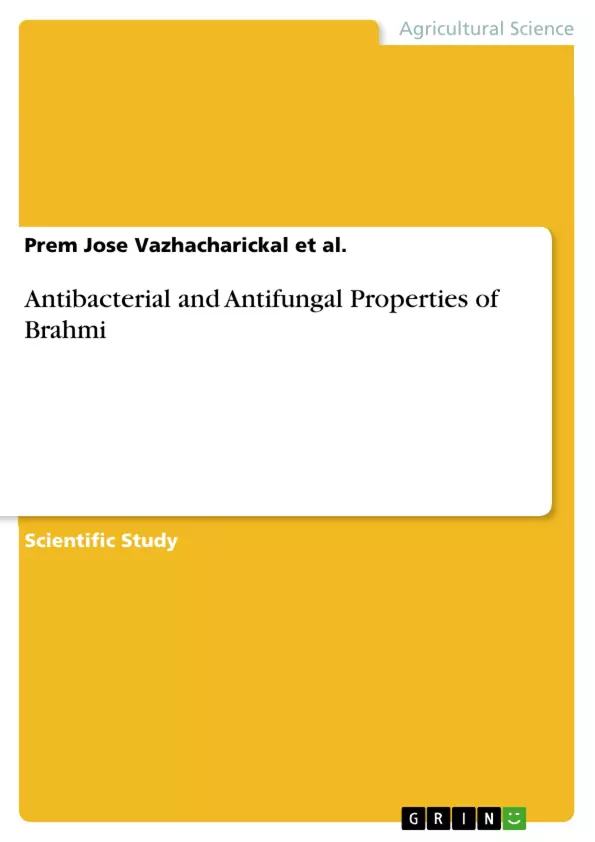Fungal and bacterial infections have increased rapidly and the wide uses of synthetic medicines have cytotoxicity on host and made drug resistance among the pathogen. The antifungal and antibacterial analysis of Bacopa monnieri (Linn) Pennell (Brahmi) was conducted in the present investigation.
Various extracts (water, methanol, acetone, petroleum ether and chloroform) of dried Brahmi leaves and stem were tested against two strains of fungi- Aspergillus niger and Candida albicans as well as bacterial strains. The antibacterial and antifungal activity of different plant extracts was determined by agar well-diffusion method using Muller hinton agar and Sabouraud dextrose agar. The methanol extracts of Brahmi leaves shows inhibition zones on Aspergillus niger (12.3 ± 0.6), Candida albicans (12.3 ± 0.6), Staphylococcus species (12.3 ± 0.6) and Bacillus species (12.3 ± 0.6). Water extract does not seem to have any good antimicrobial activity against all above mentioned the test microorganisms.
The present in vitro investigation results shows that the extracts of Brahmi leaves and stems show good antifungal and antibacterial activity. The study also concludes that methanol and acetone extracts showed good higher efficacy of the bioactive compounds.
Inhaltsverzeichnis (Table of Contents)
- Studies on antibacterial and antifungal properties of Brahmi (Bacopa monnieri (Linn) Pennell)
- Abstract
- Introduction
- Objectives
- Scope of the study
- Taxonomical classification
- Hypothesis
- Materials and Methods
- Study area
- Plant sample collection
- Preparation of extract
- Microorganism
- Agar well diffusion tests
- Statistical analysis
- Results
- Discussion
- Conclusions
- Conflict of interest statement
- Acknowledgements
- References
Zielsetzung und Themenschwerpunkte (Objectives and Key Themes)
This study investigates the antibacterial and antifungal properties of Brahmi (Bacopa monnieri (Linn) Pennell), a plant commonly used in traditional medicine.
- Evaluating the antimicrobial activity of different extracts of Brahmi
- Examining the effectiveness of Brahmi against various bacterial and fungal strains
- Understanding the potential of Brahmi as a natural antimicrobial agent
- Exploring the role of different solvents in extracting bioactive compounds from Brahmi
- Contributing to the scientific understanding of Brahmi's medicinal properties
Zusammenfassung der Kapitel (Chapter Summaries)
- Introduction: The introduction provides background information on Brahmi, including its traditional uses and potential medicinal benefits. It outlines the objectives, scope, and hypothesis of the study.
- Materials and Methods: This chapter details the methodology used in the study, including the study area, plant sample collection, extract preparation, microorganisms used, and the agar well diffusion tests conducted.
- Results: The results section presents the findings of the antimicrobial activity tests, showcasing the effectiveness of different extracts of Brahmi against various bacterial and fungal strains.
- Discussion: This chapter analyzes the results, discussing the potential mechanisms of action and the implications of the findings. It explores the relationship between the effectiveness of extracts and the solvents used.
Schlüsselwörter (Keywords)
Brahmi, Bacopa monnieri, antimicrobial activity, antibacterial, antifungal, traditional medicine, natural product, solvent extraction, agar well diffusion test, microorganisms, medicinal properties.
- Quote paper
- Dr. Prem Jose Vazhacharickal et al. (Author), 2016, Antibacterial and Antifungal Properties of Brahmi, Munich, GRIN Verlag, https://www.hausarbeiten.de/document/359220


